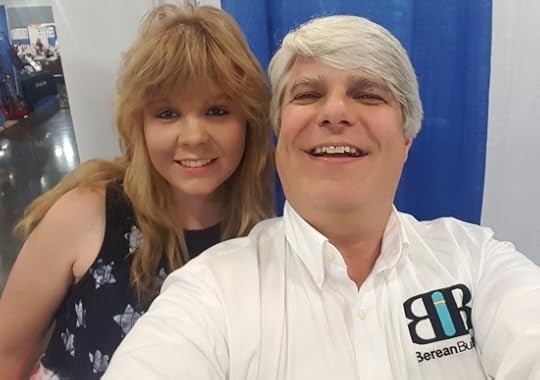Can Courses Taken in Junior High Be Included on a High School Transcript?

Me and Savannah, a scientist in the making!
I just got back from Ontario, California, where I spoke at the California Homeschool Convention. I gave a total of five talks over the three-day conference, and I had the chance to speak with lots of homeschooled students and their parents. Several wonderful things happened at the conference, but the highlight for me is pictured above.
On Friday, a young lady named Savannah came up to my publisher’s booth and asked if I was Dr. Wile. I said yes, and she proceeded to tell me that she loved my biology textbook and planned to major in biology at university. I tried to express how much that meant to me, and then she hesitantly asked if I would sign her copy of my book. I said, “Of course!” She didn’t have it with her, but she promised to bring it the next day. Late into the convention on Saturday, she returned with her book, and when she handed it to me, she said, “This is my favorite book in the entire world!”
I had no idea what to say to that. While a lot of students tell me that they love my textbooks, and many of them have also said that my textbooks have inspired them to study science at university, I have never had anyone tell me that one of my books is their favorite book in the entire world! I have lots of favorite books, and none of them are science-related! Don’t get me wrong, there are a lot of science-related books that I really love, but I wouldn’t list any of them as my favorites. When I think of my favorite books*, I think of fictional works like The Chronicles of Thomas Covenant (my all-time favorite series), The Lord of the Rings, and Armageddon’s Children. Not a single science-related book comes to mind. Needless to say, I was overwhelmed by Savannah’s words.
Even though that was the conversation I will never forget, I did speak to many other people. One homeschooling mother came to my publisher’s booth very concerned. She told me that her child was bright and was way ahead of where he “should be.” I stopped her right there and tried to dispel the notion that a student “should be” anywhere at a given age. We are all individual creations of God, and we all have our strengths and our weaknesses. The only place we “should be” when it comes to learning is to be learning more.
She went on to say that this presents a problem for her. He will technically be in 7th grade next year, but he will be taking Algebra 1. I told her that was wonderful and said she might consider having him do my biology course, because for most students, it pairs very well with Algebra 1. This seemed to frustrate her, and she asked if that wouldn’t just mess thinks up even more. I asked her what she meant, and that’s when we hit the heart of the matter: She was worried about her son’s high school transcript. She thought it would look weird if it didn’t include things like Algebra 1 and biology.
This mother’s misconception is common enough that I decided to share my answer with all my readers, hoping they will share it with others: When it comes to including a subject on a high school transcript, the age of the student is not important. The only thing that matters is the level of the course. If it is truly a high-school-level course, it should be included on a high school transcript, regardless of when the course is taken. A complete Algebra 1 course, for example, is universally recognized as a high-school-level course. Thus, it should be included on the transcript, even if the student takes it when he or she is in elementary school!
But how do you actually do this? It depends on how you organize your transcript. Some transcripts, like this one, are arranged chronologically. If that’s how you are doing your transcript, simply add a section prior to the one that covers the freshman year. Title it, “High School Courses Taken Early as Part of an Accelerated Program.” This will tell the person reviewing the transcript that your student was advanced (compared to the average university-bound student) and took some high-school-level courses before he or she was technically in high school.
The other way you can do it is to arrange your transcript by subject instead of chronologically, like this one. When you arrange your transcript this way, the age at which the student took the course doesn’t even come into play. Both types of transcripts are common, so anyone who reviews transcripts will be familiar with both. Use whichever one makes you the most comfortable.
The main point is that you should never hold your student’s progress back. You shouldn’t try to artificially accelerate your student’s advancement, either. You should help your student find the pace that challenges but doesn’t overwhelm. That’s the “sweet spot” of learning. Don’t worry about transcripts or “running out” of things to cover in later years. Allow your student to learn at his or her own pace, and you will be doing significantly better than the vast majority of schools!
Note added later: A commenter on my Facebook page brought up the fact that the NCAA has specific requirements for students wanting to play in college sports. If your student is thinking of doing that, get their transcript toolkit.
Jay L. Wile's Blog
- Jay L. Wile's profile
- 31 followers



